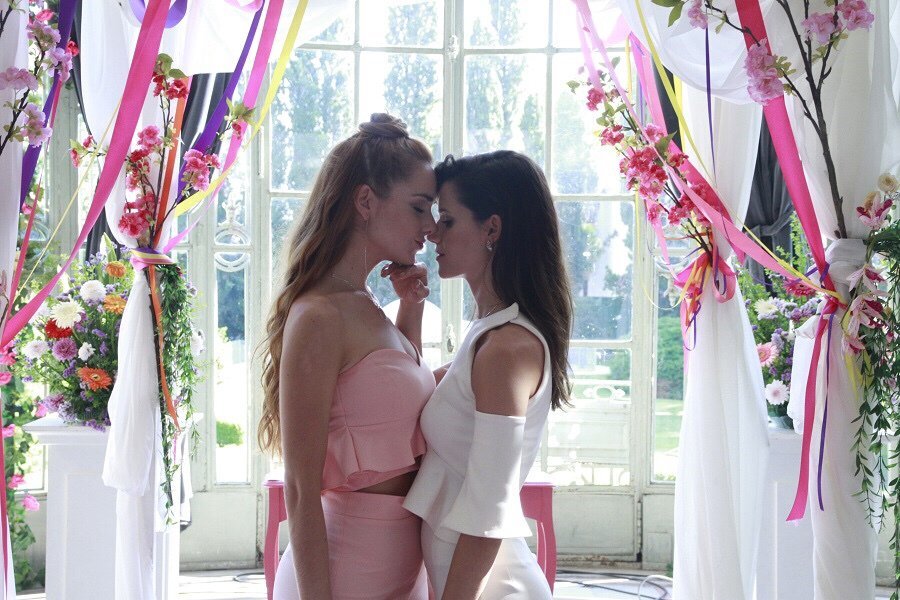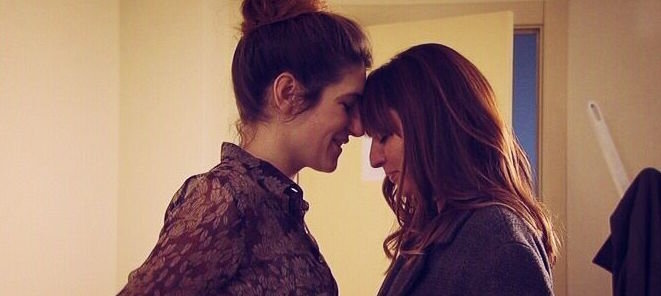The Lesbian Unhappy Ending Problem
By Karen Frost
2016 was a landmark year in queer female history. It was the year so many queer female characters were killed on US television that even the mainstream media noticed. After decades of LGBT representation being a mostly “niche” issue with occasional mentions in the mainstream, the “Bury Your Gays” trope (or “Dead Lesbian Syndrome,” as the Spaniards call it) briefly became the entertainment industry topic du jour. The death of the character Lexa on “The 100” was the butterfly in Edward Lorenz’s chaos theory, forcing the entertainment industry not only in the US but throughout the world to look introspectively at its treatment of queer women on television and confront what was, statistically, the genocide of an entire class of fictional characters.
The story of how Bury Your Gays caught the national media’s attention is a story about numbers. Although queer women had long recognized a problem with lesbian representation on a qualitative level, it was only in 2016, in the days after Lexa’s death, that they began to quantify this problem. In March 2016, Autostraddle created an infographic that starkly laid out the magnitude of the Bury Your Gays problem. Of the 193 American scripted television shows airing between 1976 and 2016 that had queer female characters, the queer female character was killed off on 68 (35%) of them. This was the first time anyone had pinpointed the jawdropping extent of America’s dead lesbian problem: a third of all American television shows with queer female representation had ended up killing off their queer female character. Autostraddle also found that of the 383 queer female characters to ever appear on American scripted television, a demoralizing 95 (25%) had been killed. The genocide was real, and it was calculable.
In June 201 6, Vox calculated that 10% of all the US primetime network and streaming platform series deaths in the 2015-2016 television season were queer women. Given queer women were only 2% of all characters that season, that meant they were killed at a rate five times higher than every other character. Put another way, by Vox’s count three times more queer female characters were killed in the 2015-2016 season (22) than characters on “Game of Thrones” (7). Such egregious statistics indicated to every observer a single conclusion: the genocide of queer female characters needed to be stopped, because it was getting out of hand.
Because of the extreme scrutiny generated by the dozens if not hundreds of articles on the topic, the entertainment industry—globally, not just in the US—responded positively and proactively. Per statistics compiled by LezWatch.TV, while 14% of queer female characters were killed internationally in 2016, by 2018 that number had dropped to only 3% (although still 8.6% in the US). This was a fantastic and much needed development, and the conversation in the mainstream media shifted naturally away from further discussion of Bury Your Gays, considering the case closed. In the queer community, the focus largely returned to the long-term, perpetual push for more queer characters to increase representation globally.
But in some ways, the focus on Bury Your Gays was an identification of a symptom without recognizing the underlying illness: the lesbian unhappy ending problem. Per Autostraddle’s infographic, only 8% of queer female characters on US shows got a happy ending. If that’s not bad enough, that’s a mere 30 characters in the whole of US history. And the US isn’t an outlier. Out of the 1,452 shows LezWatch.TV has catalogued around the world with queer female, trans, or non-binary characters as of April 2020, only 77 (5%) are tagged as having happy endings for its characters. Although statistics don’t exist on happy endings for heterosexual TV characters that would enable a direct comparison, an estimated 60% of heterosexual US movie characters get some form of happy ending. It’s hard to deny bias is at play in how queer stories are told.
By unconscious bias or intentional design, it appears the world doesn’t believe queer women deserve happy endings. The statistics clearly prove a strong and extremely specific bias against queer women, one that doesn’t seem to be shared to the same extent by other minority groups, but what’s behind it? Is some wizard hiding behind the curtain muttering spells to prevent queer couples on TV from riding off together into the sunset? Most likely, the below factors have come together to create a perfect storm of unhappy endings:
Every year, millions of queer women around the globe look for positive examples of representation to uplift and entertain them. They hope to find something that gives them hope a happy ending is possible even if they live in countries where homosexuality is repressed or criminalized. In 2020, however, it remains extremely difficult to identify queer female television couples whose storyline had a happy ending and then find that storyline online. For many languages, there may exist only one storyline, for example Catalan (“La Riera”) or Tagalog (“The Rich Man’s Daughter”). According to LezWatch.TV’s data, only 32 of of the world’s 195 countries have had even one show with a queer female, trans, or non-binary character, meaning particularly outside the English-speaking world, every storyline counts. Therein is the crux of the lesbian unhappy ending problem: if the global queer female community can count the number of happy endings it can watch on only a few hands, there aren’t enough of them. The problem is not just dead lesbians, it’s dead storylines.
Legacy of the Hays Code. Between 1934 and 1965, the Hays Motion Picture Production Code, also known as the Production Code or the Hays Code, set guidelines for US filmmaking. Although queer content was tacitly forbidden under the code, beginning around World War II the code was interpreted to allow the depiction of LGBT characters so long as they were either villains or depressed, pathetic figures. These characters always received unhappy endings so their “perversion” would be suitably “punished” in the public eye. Although the code was abandoned half a decade ago and Hollywood has significantly liberalized since the 1990s, some of the outlines of the code persist even today, consciously or subconsciously. (Other places where we see echoes of the code include the lack of interracial relationships and the trope of women being the first to die in horror movies as punishment for their “promiscuity.”)
#HollywoodSoMen. In 2019, the Writers Guild of America reported only 35% of TV writers and 24% of showrunners were women. As of 2016, 26% of TV’s executive producers and 10-20% of episode directors were women. Although no data exists for how many writers are queer, 68% of LGBT writers in a 2019 Think Tank For Inclusion & Equality study reported they were the only queer writer on the staff. Minority writers also reported widespread discrimination against minority storytelling. So who’s writing, directing, and producing queer storylines? Straight white men. Studies have consistently shown that minorities get more screentime and more positive outcomes when their creators are diverse. The absence of diversity behind the camera means the stories of queer women are being shortchanged at the expense of heterosexual stories.
Genres influence endings. In my article on Argentinian telenovelas, I pointed out that lesbian couples have all gotten happy endings on telenovelas because the genre by nature gives its characters happy endings. Historically, however, queer female characters have most commonly appeared in genres that tend to give unhappy endings: crime, action, soap operas, dramas, etc. It’s not just queer women on these shows who get unhappy endings, everyone does.
LGBT characters are considered disposable secondary characters. “Women in Refrigerators” is a comic book trope whereby female characters are injured, raped, or killed as a plot device to advance a male character’s story arc. Per writer Gail Simone, who identified this trope, the trope exists because women are less often the main character in comic books and are therefore considered disposable while the male primary character is not. Because queer characters on television (like all minority characters) are usually secondary characters, this makes it vastly more likely they’ll be killed or suffer other unhappy fates when writers need to add an emotional twist.
Misogyny/shock value. In 2009, the ultra-conservative Parents Television Council reported incidents of violence against women (injury, rape, murder) on mainstream US television had increased by 120% in the past five years. A 2012 study found that unlike male characters, female characters were more likely to be killed by up close and personal methods like beating, stabbing or strangulation than from a gunshot. Whether this uptick in violence against women is due to unconscious misogyny or the belief that a shocking death will spike ratings and engage viewers, writers are writing more violent, more gruesome fates for their female characters. By virtue of their gender, queer female characters have been casualties of this trend.
Pride. Several writers and showrunners have admitted they were aware of the Bury Your Gays trope and still chose to kill their queer female characters knowing the sadness and outcry it would cause. Even after Lexa’s death, some writers and showrunners argued that asking them not to kill their queer female characters would be a restriction on their creative freedom and a form of censorship. This attitude toward minority representation indicates education about tropes isn’t the only cause of lesbian unhappy endings; some creators simply enjoy creating unhappy endings.
Every year, millions of queer women around the globe look for positive examples of representation to uplift and entertain them. They hope to find something that gives them hope a happy ending is possible even if they live in countries where homosexuality is repressed or criminalized. In 2020, however, it remains extremely difficult to identify queer female television couples whose storyline had a happy ending and then find that storyline online. For many languages, there may exist only one storyline, for example Catalan (“La Riera”) or Tagalog (“The Rich Man’s Daughter”). According to LezWatch.TV’s data, only 32 of of the world’s 195 countries have had even one show with a queer female, trans, or non-binary character, meaning particularly outside the English-speaking world, every storyline counts. Therein is the crux of the lesbian unhappy ending problem: if the global queer female community can count the number of happy endings it can watch on only a few hands, there aren’t enough of them. The problem is not just dead lesbians, it’s dead storylines.




